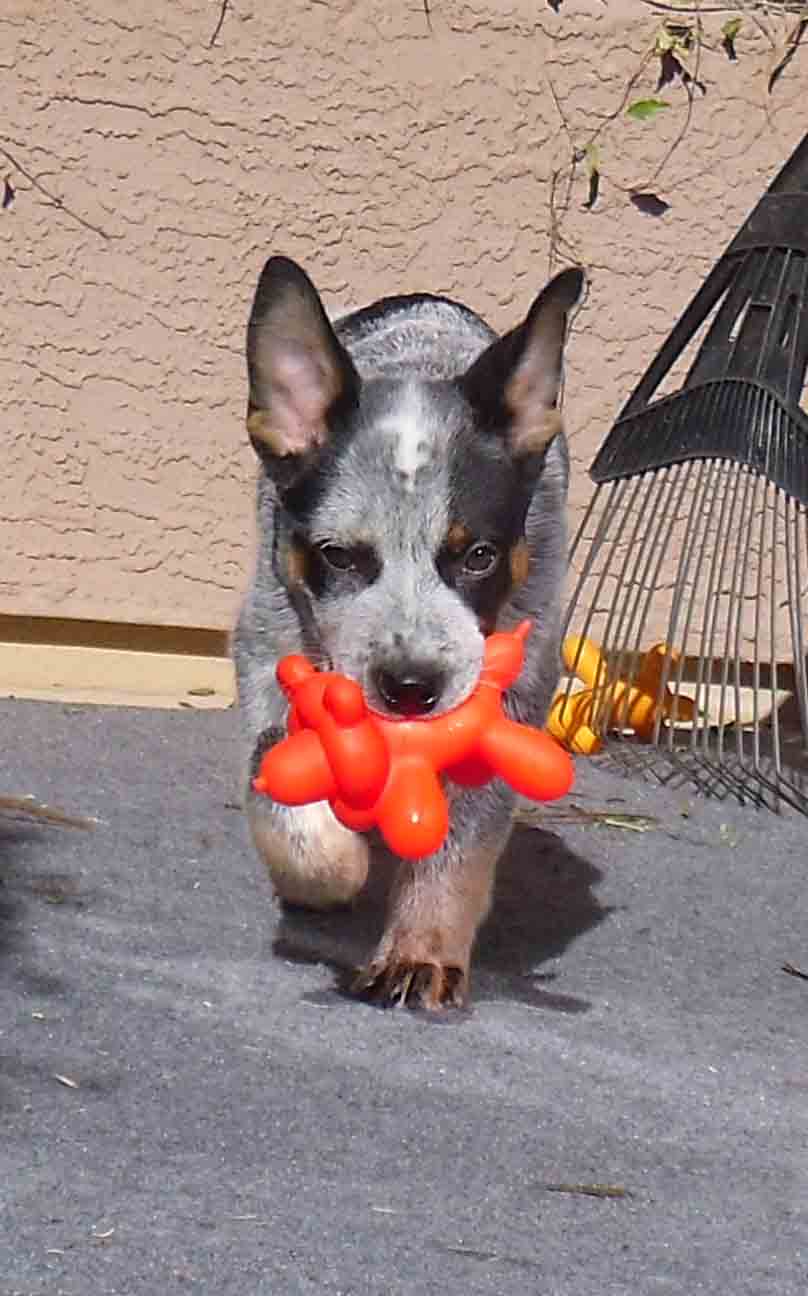I taught my Cattle Dog, Petey, to ‘roll over’ about two and a half years ago to please my wife. Both of us got tired of it, especially me – it competes with a preferred behavior of turning around to face an opposing direction. The other day, while working on turn around, Petey threw in a ‘roll over’. Why is that important? Because I have not reinforced that behavior for over two years, since he was a pup.Why is that important? Becaus e it demonstrates a very important point. Teaching a competing behavior does not remove an existing behavior. You are merely adding to the dog’s repertoire. A simple miscue can instantly bring the behavior back, full strength. If you rely on teaching an ‘alternate’ behavior to suppress something you never want to see again, you run the risk of getting it when you least expect it.
e it demonstrates a very important point. Teaching a competing behavior does not remove an existing behavior. You are merely adding to the dog’s repertoire. A simple miscue can instantly bring the behavior back, full strength. If you rely on teaching an ‘alternate’ behavior to suppress something you never want to see again, you run the risk of getting it when you least expect it.
As many trainers now claim to be scientific they may object to my statements because virtually all behavior analysts and ‘dog behaviorists’ suggest teaching a competing behavior as if it can neutralize other behaviors. They can’t all be wrong, can they? Yes, they can. That is because a greater scientist proved the point almost 100 years ago. Someone who didn’t buy old-wives-tales or new-expert-tales. His name was Ivan Pavlov.
One of Pavlov’s experiments made a connection between the sound of a bell and food. Once he achieved a 100% food response by just ringing the bell, he continued to ring the bell until it produced no effect. This is what the ‘alternate behavior’ folks want you to believe. The association somehow disappeared and won’t return. That isn’t what happens. Pavlov waited two hours and rang the bell again. Before you read the answer, take your eyes of the screen and come up with a percentage of strength you think happened after extinction followed by two hours of no reinforcement. Waiting. Waiting. Waiting.
Okay, I’ll tell you. 100%. The association didn’t go anywhere. Nature requires some behaviors and associations to disappear for a while based on circumstances. The location of a dried up waterhole may cause an elephant to walk right past it. After the rains come, it might kill him to ignore the previous association. So, no, teaching an alternate behavior doesn’t remove existing behaviors. That is because knowledge is additive. If you learn how to analyze and store photo negatives it doesn’t remove your knowledge of how to ride a skate board. I may pay you more to care for photo negatives, but your skateboard skills are still there. If you want to see this in action, take a look at Ben Stiller’s “Walter Mitty” movie – or teach your dog to roll over and watch how it comes back when you least expect it.

I wonder if the dog choses to evoke an old behavior in order to test it against the handler’s request or to placate the handler into leaving him alone or something else all together? I agree that if a behavior was once well learned that even if it is not requested for a long time the animal may try using it and if it doesn’t get the response it wants just puts the behavior back on the shelf. It seems to me when something is well learned the neurons have made chemical connections that unless damaged still exist.
Sharon,
The point of the article is the wide-spread belief that if you teach another behavior it somehow makes old behaviors disappear. For instance, if a dog jumps up on people, teach it to sit, instead. That is a false assumption, yet it is the primary solution to problems within behavioral science and modern dog training. Teaching a dog to roll over instead of chasing squirrels doesn’t affect the dog’s ability to chase squirrels. At best it makes it preferable to roll over. When the continuous effort to reinforce rolling over skips a beat, the dog chases squirrels. That is because our repertoires are not either/or. I learned to enjoy deep fried mushrooms when I was in college. That didn’t make me stop eating French fries.
My dog chases joggers . i may be able to teach him not to say99%. of the time but there’s always the chance he may do it again as its in his neural pathway?
Melanie,
The task is to learn how to stop a behavior, any behavior. Then apply what you learn to the process of chasing joggers. If the dog is on leash, use a halter. If the dog is not on leash, you must first develop off-leash control and then work toward using you new recall control.
However, your objection regarding neural pathways begs the question of whether any previously learned behavior can be stopped and inhibited. The answer is yes, regardless of how deeply imbedded it might be. The rules for inhibiting behavior can be found in my series of articles on aversive control. Just type that term in the search box. 🙂
I have never witnessed long term extinction. What’s worse is trainers telling people to use extinction, because they will not be able to do it correctly . They think they are witnessing an extinction burst when the behavior increases in duration or intensity. And LOL they just keep waiting for months or years for that extinction burts to be over while their dog jumps on people for 15 minutes instead of the 1 minute before the trainer told them to ignore it . Oddly many of these dog owners are parents who know how to stop unwanted behavior in young children.